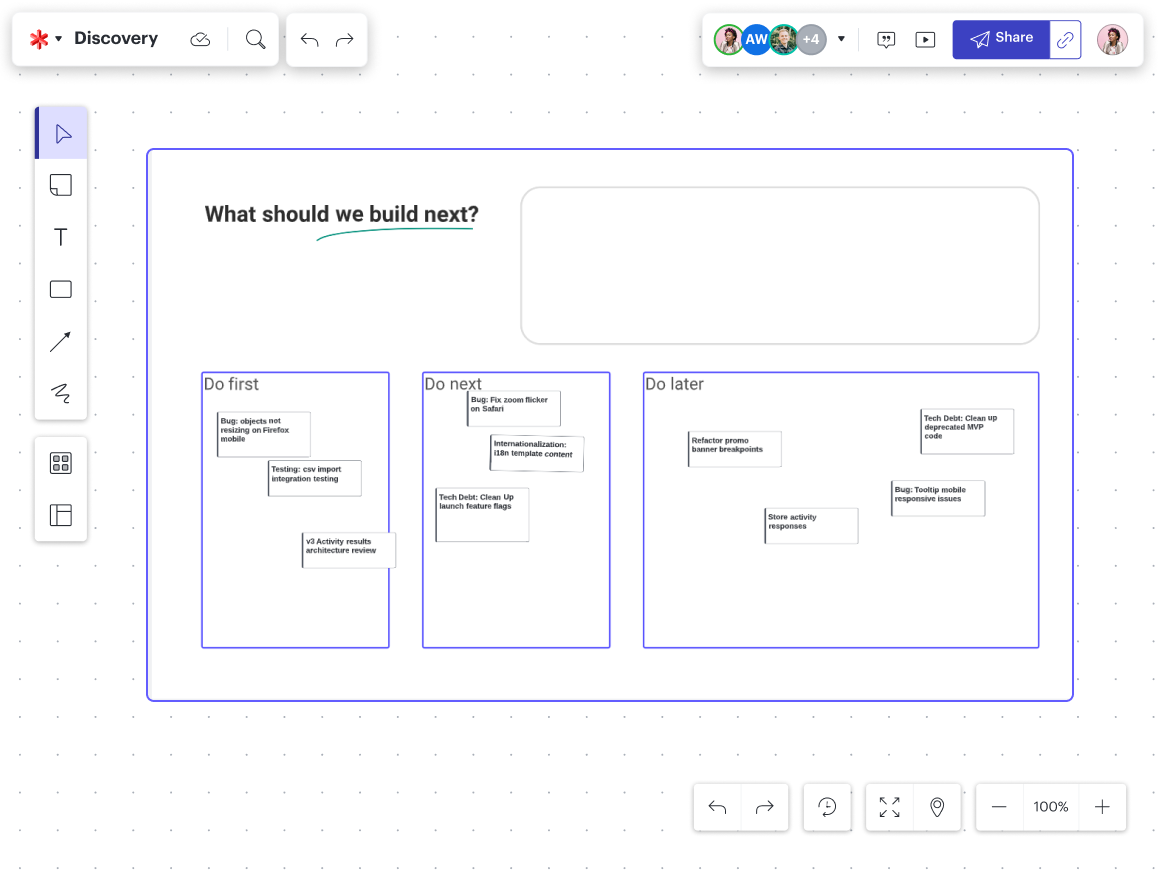
4 essential attributes your innovation team needs
Reading time: about 11 min
Innovation is a key driver of business success and longevity. So it’s no surprise that 83% of companies now rank innovation as a top-three priority. But what may surprise you is that just 3% are actually ready to deliver on those innovation goals, according to a report by Boston Consulting Group.
A dedicated innovation team can help you bridge that readiness gap.
Innovation teams help organizations break from the status quo to create opportunities for strategic growth and investment. However, while building an innovation team is the secret to success for many businesses, it can be difficult to know where to start when assembling your innovation heroes. For instance: What makes a good innovation team structure? Who is a good fit? What experience, skills, or attributes should you look for?
Jeff Rosenbaugh, senior director of professional services at Lucid, and Christopher Bailey, principal professional services consultant at Lucid, have identified four essential attributes of an innovation team throughout their years of experience helping organizations scale innovation. Bailey and Rosenbaugh have seen firsthand that while anyone can have a role on an innovation team, there are specific skills and qualities that make people—and the team as a whole—successful innovators.
By focusing on these key attributes, you can better identify, assemble, and optimize your innovation team.
Below, we’ll cover what these four essential attributes are, how they fit into innovation roles, and how to overcome key challenges to building your innovation dream team.
What is an innovation team?
Before we dive into the nitty gritty of innovation team attributes, let’s first define what an innovation team actually is:
An innovation team is a group of people within a larger organization who identify and develop new ideas that will help the company grow.
Innovation teams are typically targeted at specific organizational objectives (e.g., new product identification and development, new business model investigation/design, shifting the business toward the future, etc.). Innovation teams are not as useful for core innovation, which is best done by people within their day jobs, as those people have all the context of the role and work.
“Innovation teams are often pulled together as a cross-functional team, representing the key skills the business believes will be vital to finding success. While they will still bring domain knowledge, their role is to create sparks at the intersection of their experience that will result in something new,” explains Rosenbaugh.
To make this happen, the innovation team needs to define and measure success (i.e., what will innovation actually look like?) and determine how they will accomplish their end goals. (End goals are often defined by the executive stakeholders who put the team together.)
Due to their focus specifically on innovation, people in innovation roles are a core part of innovation management—helping organizations innovate intentionally and strategically.

Innovation management guide
Get the techniques and tools you need to scale innovation at your business.
Read the guideCommon challenges to building an innovation team
Building a successful innovation team isn’t just about finding the right people. There are a number of high-level and even cultural challenges you may have to overcome first. These are three of the most common challenges.
Unclear strategy
The biggest challenge: the lack of a clear innovation strategy.
Despite investing in ongoing innovation projects, most companies are not successfully linking their business and innovation strategies.
Instead, too many organizations are “just going through the motions of innovation without a clear strategy to focus their efforts,” says Justin Manly, a BCG managing director and partner and coauthor of the BCG 18th Annual Innovation Study.
Part of this challenge includes determining specific goals for team innovation and defining what successful innovation looks like for your teams. Without this fundamental direction, it will not only be difficult to assemble the right people, but once you do, they won’t have the information they need to effectively focus their efforts.
So, before doing anything else, identifying and linking your business and innovation strategies is critical.

How to build an innovation strategy
Learn just what you need to create a scalable innovation strategy.
Go nowTime management
Innovation is a deeply creative and thought-driven pursuit. Because innovation comes with so much uncertainty (after all, you’re exploring ideas and opportunities without fully knowing the result), time can quickly get away from you.
For instance, without clear goals and strategies to guide your innovation work, it is easy to go down rabbit holes, spend too much time on ideas or projects that don’t align with your innovation objectives, and fall into the trap of classic scope creep.
These challenges can lead to wasted time and resources—often leaving you with little to show for those efforts. So, it’s important to set up strong goals, milestones, and timelines for assessment, funding, and decision-making. Creating strong time management processes from the start will help you keep your innovation projects on track.

Curiosity and other innovation skills
Learn the top skills that you can develop to become a more innovative person.
Read moreBeing open to new ideas and feeling comfortable taking risks
Do you have a strong innovation culture? Or do you have the right conditions for team innovation? Many organizations have not invested in the tools and processes needed to foster innovation and empower their people to take risks without fear of repercussions. If your team feels they don’t have the space to experiment or fail, they will be reluctant to take the steps needed to innovate.
So it’s important for innovation teams to foster a culture of creativity, risk-taking, and exploration of new and diverse ideas. Use inclusive collaboration strategies as an opportunity to gather input from everyone and ensure that each person’s voice is heard so you have a wide variety of ideas to start with.

Innovation team structure
Anyone can be part of an innovation team. Who you bring on and how you structure the group will depend largely on your innovation strategy and goals.
For most teams, this will include people with specific domain expertise (though businesses may often select someone with fresh thinking and less depth of experience), as well as strong leadership.
Since many innovation teams run like Scrum teams, this usually means they’ll include a product or program manager who can take the lead on ensuring goals are measured and achieved.
Pro Tip: Keep in mind that while strong leadership is important, a key aspect to successful innovation teams is fostering a supportive culture where everyone is welcome to contribute ideas and participate.
Additionally, while not usually direct team members, executive stakeholders should be closely involved in order to lower barriers and provide needed resources and any support the team may need.
Often, innovation teams start small and then grow over time as they further narrow their focus and pull in more people to support their goals or add cross-functional insights to their work.
The 4 most important attributes of innovation teams
Once you know what types of roles you need to fill on your innovation team, you can start looking for the specific attributes your final roster should have. For instance, you may have people you’re considering for the team—but chances are not all candidates have all four key attributes you need.
Remember: These four attributes aren’t options; they’re attributes that innovation team members should each emulate. To build an innovation team, you’re not looking for one farmer, one venture capitalist, and so on. Ideally, all of these aspects are qualities that each innovation team member has.
Here’s what to look for when assembling your innovation team:
1. Secure resources and connections like a venture capitalist
Venture capitalists’ strength is in making connections—whether that’s to funding, people, or other key resources.
“They have connections all throughout the organization and the industry,” Rosenbaugh explains. “The breadth and depth of their network enables them to take good ideas and help them grow. By harnessing these diverse resources, they can take a project to the next level.”
“When talking about venture capitalists,” Rosenbaugh says, “We do focus very heavily on the monetary aspect of what they provide to a startup company. But honestly, the venture capitalists that are the most valuable are not the ones that just provide the most dollars; they’re the ones that provide the best access to great mentors or to other partner companies.”
The best venture capitalists may even provide great mentoring themselves, as well as access to additional talent that can be brought into the company. It’s this connectivity that really offers value to an innovation team and its organization.
2. Cultivate growth like a farmer
“Not only do we need to think and act like a venture capitalist, but we also need to think and act like a farmer,” Rosenbaugh shares.
“A farmer cultivates a space, and then they allow things to grow on their own. If a farmer actually gets too involved in the growing, that can be detrimental to the growth of vegetation. Instead, they cultivate a great space, and then they step away because they've got another part of the field to go cultivate and provide support.”
Similarly, approaching innovation like a farmer means you need to provide autonomy and freedom to the team. Allow people space to grow on their own and trust the team and the process to generate value—even if you can’t see the end result yet.
Farmers also cultivate a community. “There's a whole ecosystem that exists on a farm,” Rosenbaugh says, “and they're actively cultivating [that ecosystem] to make sure that all the different parts of the puzzle fit together and work well together for the overall economic gain of the farm and total value of delivery through the system.”
3. Take risks and make the hard calls like a foreign aid worker
Innovation team members should also think like a foreign aid worker. Foreign aid workers are courageous risk-takers who are often willing to take bigger risks.
“But they’re also expecting big returns,” Bailey says, “not only for the community and individuals they’re serving but also in terms of intrinsic benefits for themselves.” Foreign aid workers are passionate about what they do and why they do it.
“They're really truly on board with the cause. I think that's one of the most important things—if we're leading an organization or leading an initiative, we need to have passion about what we're doing. And if we don't have that, we need to find it. We need to figure out why we are doing this thing in the first place.”
This mindset allows foreign aid workers to make the hard calls because they understand when they’re losing passion or something isn’t providing value. When that happens, they refocus their resources on something else with a level of compassion.
Being able to take big risks and make difficult decisions is essential in innovation work because the hits often come to the people recommending big changes. Challenging the status quo or an existing business line or value stream can provoke resistance from an organization. But if you have the passion and buy-in, you can stand by your decisions, knowing it's the right call—even if it's hard.
4. Invest in data like a stockbroker
Finally, innovation team members should think like a stockbroker.
Stock brokers are very data-driven in their decision-making. They’re looking for ways to diversify their portfolio, mitigate risk, and gather a diverse set of data to guide what actions to take next.
“If your teams are actively engaged in integrating their work with the feedback that they're getting from their customers, there should be a lot of customer anecdotal information, which is extremely relevant data if you're working in a new space and focusing on a new thing,” Rosenbaugh explains.
That information and feedback can then help innovation managers understand:
-
Where do I need to diversify?
-
What are the decisions I need to make?
-
How do I need to communicate?
“[Thinking like a stockbroker] can be extremely detached from emotion,” Rosenbaugh says. “Given the personal side of what it takes to be an innovative person and how much of yourself you're putting on the table when you're doing this kind of work, you have to make sure that as a leader, you're marrying this [attribute] with the other three.”
In other words, innovation leaders should have and rely on all four attributes to guide and inform their work.
Rosenbaugh explains, “You really need to think holistically. What does this person look like that encapsulates all these different attributes? Everybody’s going to have their own strengths and weaknesses across these attributes, but if you go in saying ‘I only want to be a farmer,’ you may not be making the best choices. The best farmers are the ones who are also really good business people, and they’re extremely engaged in their communities.”
Kickstart innovation on your team with Lucid
As you build your team around these four key attributes, you’ll start to cultivate an environment that drives innovation. Remember that your innovation team members should embody all four attributes, and that anyone can be part of your innovation team.
Start building a culture of innovation today with Lucid.
The Lucid Visual Collaboration Suite enables individuals and teams to brainstorm, plan, build, collaborate, and share ideas all from one platform. Between Lucid’s virtual whiteboarding and intelligent diagramming capabilities, you can manage innovation from start to finish.

Turn your ideas into action
Learn how to use an innovation framework to provide structure throughout your entire innovation process.
Read nowAbout Lucid
Lucid Software is the leader in visual collaboration and work acceleration, helping teams see and build the future by turning ideas into reality. Its products include the Lucid Visual Collaboration Suite (Lucidchart and Lucidspark) and airfocus. The Lucid Visual Collaboration Suite, combined with powerful accelerators for business agility, cloud, and process transformation, empowers organizations to streamline work, foster alignment, and drive business transformation at scale. airfocus, an AI-powered product management and roadmapping platform, extends these capabilities by helping teams prioritize work, define product strategy, and align execution with business goals. The most used work acceleration platform by the Fortune 500, Lucid's solutions are trusted by more than 100 million users across enterprises worldwide, including Google, GE, and NBC Universal. Lucid partners with leaders such as Google, Atlassian, and Microsoft, and has received numerous awards for its products, growth, and workplace culture.
Related articles
Innovation management guide: Techniques and tools to scale innovation
Maximize ROI on your innovation projects with tips from Lucid’s own innovation experts.
How to develop an efficient innovation process
Bringing new ideas to life is not a linear process. Let’s examine the phases of innovation and review actionable tips for making them more efficient.
Guide: How to use an innovation framework to turn ideas into action
Don't leave innovation up to chance. Learn how to use Lucid’s innovation framework to make innovation a repeatable, scalable occurrence.
The top innovation skills for the workplace (with tips + templates)
Learn our top innovation skills to have in the workplace, with tips and templates to get you started.
